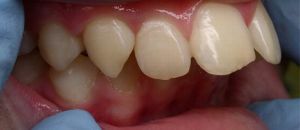 Correct bite makes the person's face proportional, pleasant to others. Any deviation in the location of the dentition entails a large number of problems.
Correct bite makes the person's face proportional, pleasant to others. Any deviation in the location of the dentition entails a large number of problems.
As a rule, they are associated with a violation of swallowing and chewing processes. Such pathologies include distal occlusion( occlusion).This is a common dental diagnosis, but not a sentence.
Any deviation can be corrected by a qualified technician.
Distal or prognathic bite is an anomaly characterized by a disproportional arrangement of jaws. The upper is more developed than the bottom, it protrudes forward. Such a defect complicates the full-fledged closing of the teeth, which causes aesthetic discomfort.
Contents
- Pathology development mechanism
- Betelman and Engle classification
- Basic causes
- Features of the clinical picture
- Diagnosis and therapy disorders
- Consequences and complications of the pathology
- Preventive measures
Mechanism of the pathology development
Similar defects begin to form in infancy. Therefore, in childhood they are easier to adjust. The mechanism of malocclusion is quite simple.
The baby appears with a distal predisposition. The lower jaw is slightly pushed back so that there is a small gap between the gums. This structure of the device is necessary for unhindered breastfeeding. In the process of natural nutrition and correct introduction of complementary foods, the lower jaw gradually fits into place.
Permanent artificial feeding is very dangerous. Occlusion can form quickly, as the jaw develops incompletely. Of course, there are other factors contributing to the development of anomalies.
Betelman and Engle classification
The disproportional arrangement of the jaws in modern orthodontics has several classifications. All of them are offered by different 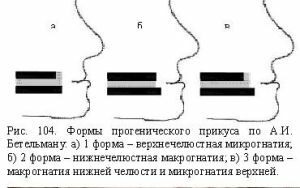 scientists. However, two systems are used as a basis: according to Betelmann and Engle. Let's consider each classification in more detail.
scientists. However, two systems are used as a basis: according to Betelmann and Engle. Let's consider each classification in more detail.
Abram Betelman suggested dividing the pathology by clinical varieties:
- underdeveloped lower jaw;
- excessively large upper jaw with large teeth;
- simultaneous development of two pathologies;
- protrusion of the upper incisors above the lower ones.
Engle distinguished two classes of prognathic occlusion. To the first, he referred cases of narrowing in the lateral parts of the dentition and displacement of the upper incisors in a fan-shaped direction. To the second class - the absence of the sagittal gap, the deflection of the teeth in the direction of the lips.
Dentists are sure that defects in bite can be "cured" up to 13 years. After this age, the formed bones are more difficult to correct.

The main causes of
The following factors influence the development of distal occlusion:
- Hereditary predisposition .This is one of the main factors that affects the appearance of dentoalveolar anomalies. Approximately in 90% of cases, the wrong bite is transmitted from the parents to the child.
- Diseases of the respiratory system ( sinusitis, runny nose, bronchitis).
- Bad habits of the .Sometimes they are completely harmless, but some can provoke the development of jaw anomalies. Often there is a habit of gnawing hard things. If the child is not disaccustomed to it in time, after several years, jaw defects in various manifestations can be observed.
- Problems with posture .Shifting the head forward affects the position of the upper jaw. It increases in size, and the lower one moves backwards.
- Premature change of infant teeth .In this case, the incisors can not develop fully, which entails bending.
- Rickets .60% of children, whose diet lacks calcium and vitamin D, shows a distal bite.
Prognatic occlusion is rarely seen as an independent form of pathology. Typically, doctors diagnose a combination of deep and distal occlusion. The severity of the defect depends on the difference in the size of the upper and lower jaws.
Features of the clinical picture
In medical practice, it is customary to identify several signs indicating an anomaly. These include:
- small chin;
- is a small upper lip;
- protrusion of upper teeth over lower jaw;
- no closure of the lips in a calm state.
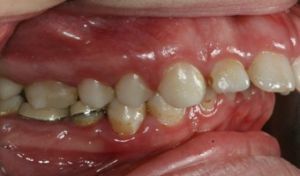
In the picture, a typical picture for the distal bite
For the distal occlusion, the occlusal only of the lateral teeth is typical. During the immediate chewing of food the incisors do not touch.
Before appointing a course of treatment, the physician should study the profile of the patient's face in detail. It is necessary to know what changes the defect correction can provoke. If you neglect the problem, occlusion can provoke a lot of problems for the full functioning of the body.
Incorrect development and location of jaws is reflected in the processes of breathing, swallowing and chewing. Small patients have problems with speech, which require speech therapy correction.
Diagnosis and therapy disorders
An experienced orthodontist can only confirm the presence of pathology due to external changes. During a clinical examination, he draws attention to the location of the teeth, the size of the jaws, their shape. To determine the type of distal occlusion, an additional examination is required, which includes:
- ( it allows to detect the disproportion of bone tissue);
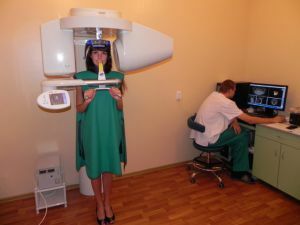
- tomography ( detailed X-ray images used for defect clarification);
- electromyography ( used to assess the functioning of the dentoalveolar system);
- rheography ( determination of vascular status).
Based on the results of a comprehensive examination, the doctor can prescribe appropriate therapy.
Prognathic bite is most easily amenable to correction in childhood, when the molar teeth have not yet been replaced by indigenous teeth. In adult patients, therapy requires a lot of effort and time. Usually it lasts about four years. This period does not include rehabilitation, which is no less important and takes about five years.
At the initial stage the doctor should eliminate the accompanying diseases of the teeth, remove the stone, perform prosthetics. Then he chooses a specific method of correction of bite, there are several:
- Myogymnia is designed to strengthen the muscles of the mouth. The greatest effect can be achieved by the following exercise: the
 is slow to move forward and backward, only the lower jaw should be used. In this case, each end position should remain for 10 seconds. This gymnastics is recommended to be performed several times a day until the desired results are obtained. Especially it is effective for correcting bite in childhood.
is slow to move forward and backward, only the lower jaw should be used. In this case, each end position should remain for 10 seconds. This gymnastics is recommended to be performed several times a day until the desired results are obtained. Especially it is effective for correcting bite in childhood. - Orthodontic therapy implies the installation of bracket systems. In addition, face arches and plates are used. In practice, various braces are used, differing in the material of manufacture, the principle of action and location. It can be ceramic, metal or sapphire. Thanks to the braces, the teeth straighten. However, with distal occlusion, they must still be pushed back. Rubber gaskets, springs and rings are used for this purpose. In small patients, special kapes and plates are most effective.
- Surgical intervention of is indicated in especially severe cases when distal occlusion is accompanied by other pathologies( facial asymmetry, abnormal chin shape).
- The combination therapy implies the simultaneous use of several treatment options. Sometimes additional consultation is required for a dentist, speech therapist and periodontist.
After the end of the course of treatment, there is always a chance of a relapse. To avoid unpleasant consequences, the patient is advised to wear a retention design. With its help you can hold a new position of the teeth. The duration of such a recovery period for each patient is individual.
Consequences and complications of pathology
If the time does not begin to correct the violation, there is a high probability of a number of unpleasant consequences. Among them are the following:
- Changing the appearance of .By the age of 15, teeth take their final position. A small chin, protruding teeth make the facial expression unnatural. This is fraught with psychological problems in the future.
- Problems with swallowing and chewing .A person does not get to properly connect his teeth, so he can not fully use the possibilities of the jaws. Such a defect is reflected in the speed of chewing food and energy expended.
- Caries .This dental disease is affected by the back teeth, which are more stressed.
- Problems with facial joints ( pain when chewing, clicks during yawning).
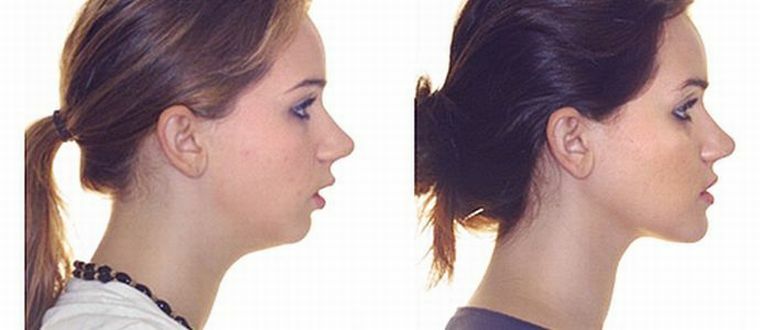
Before and after orthodontic treatment of the distal bite
The disease significantly complicates prosthetics in old age, since for the procedure it is necessary to have a maxillary symmetry.
Preventive measures
It is possible to prevent occurrence of this pathology in childhood due to elimination of provoking factors. Doctors recommend giving preference to breastfeeding, rather than artificial nutrition.
It is important to ensure that calcium is present in the diet of the child in the required quantities. It is better to control the bearing of the baby from an early age. For this, a set of special exercises can be performed daily.
Distal occlusion is a serious pathology, the lack of timely treatment of which can lead to a lot of unpleasant consequences. To fix the problem is much easier at preschool age, when surgical intervention is not required. You just need to follow the recommendations of the orthodontist and do not neglect the preventive measures.
